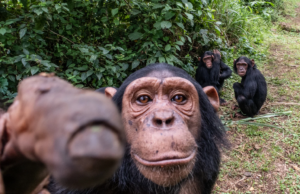The walls

Journalists and cameramen who visit Sorocaba Sanctuary sometimes inquire after theur first walk in the facilities: why the walls? We also asked ourselves that when we started the Sanctuary. The experience of more than a decade living with chimpanzees now gives us the answer.
Is there a high security prison in the human world that is not surrounded by walls? This is the first condition to consider it is safe. Within the precincts of those prisons exist intelligent beings, creative, observant, stubborn, wanting freedom. No matter they are modern humans, Homo sapiens, or primitives, Homo troglodytes.
Electric fences, ditches, water barriers, which are used in some places to avoid leakage, have been tested for both types of Homos and all were vulnerable. The only guarantee of security remains with the walls.
When we started building the Sanctuary, we made small enclosures of walls, with exit to thousands of square meters on electric fences. At that time the chimps were babies, obedient and had not reached the age of reason or willingly. However, there was a major limitation in the evening, as they should enter the walled part to guarantee safety. The risk was too high to let them loose day and night.
When they began to understand the electric fences and tested instruments to isolate shocks, to open them and run away, the nightmare was installed. So we decided to change the strategy and make great indoor walls only, which would have an extraordinary advantage: they would be free in there – day and night – and we did.
Currently there is no zoo or sanctuary, to our knowledge, that does not lock their animals before nightfall in the closed dorms. In the end, those unfortunates are “free” less than eight hours per day and 16 hours prisoners in dormitories, which in zoos are a horror show to which the public has no access.
The chimps at GAP Sanctuary in Sorocaba live in several thousand square meters, and can move with no restriction, both in the dormitories and cafeterias, as in the outer area freely for 24 hours a day. Some sleep outside when it’s warm in existing homes or in the aerial platforms, where they have access to a view of dozens of kilometers around it.
This improves the quality of life as they do not feel controlled or restrained in their liberty to come and go. When we started building enclosures of walls, we always put lots of windows, so that they can view on their surroundings, and air platforms that exceed the height of the walls, so they can see a long distance. Some chimps sleep all night on those platforms.
The captive is a disgrace, and even more to beings who have committed no crime, but have to live this way, that is the only solution that human society has created to manage the mistakes made by those individuals who took their natural habitat.
Chimpanzees understand the situation they are in, and in fact, when a leak occurrers due to open doors or mismanagement, they detect it and get out of the enclosure, but never leave the Sanctuary. They limited to merely visiting their fellows at other venues or headquarters house of the sanctuary; for those who have been created there, it is the cradle that gave them life.
When they were babies until the age of eight, we took a group each morning in the Forest of the Sanctuary in a Kombi. There were loose in a small area of ??forest, enjoying that piece of Nature. When we gave a voice to come back, all of them climbed in the vehicle and returned to their enclosures. Nobody ever got back or tried to escape or stay in the woods. Since then they have understood the sense of security the enclosures gave them, where there were no hidden dangers. Security for both Homos – modern and primitive – is the main factor that makes the quality of life they desire. The walls, sadly, also provide the same security.

 Español
Español
 Português
Português








